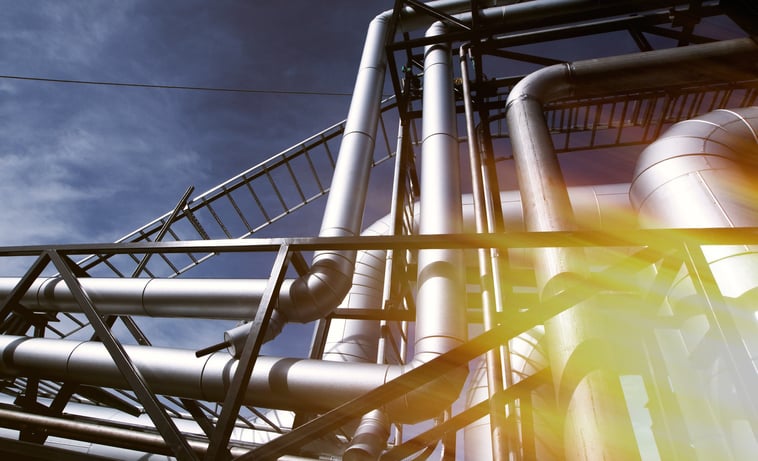
Thinking about adding pipe supports to your piping system? First, ask yourself one key question: “What material will serve my system the best?”
If you’re considering metal pipe supports, read on. We’ve laid out the ins and outs of metallic pipe supports and broken down exactly how you can use them to improve your piping system’s performance.
Advantages of Metallic Pipe Supports
Wondering why metal is such a popular material in the piping world? It all comes down to strength. In pipe supports, metal is an advantage because it features a combination of five specific strength qualities:
Tensile Strength
Tensile strength measures how well a material performs when you try to stretch it. Chewing gum has a low tensile strength. Metals, however, tend to have extremely high tensile strength, which means they’re less likely to be pulled apart and break in high-performance systems.
Compressive Strength
Basically, compressive strength is how durable a material is when it is pressed together. Because metal has a high compressive strength, it is usually a good option if you have to stack massive pipes on top of it. Case in point: pipe supports, such as ProTek Flat Plates, that can withstand thousands of pounds of pressure.
Yield Strength
Yield strength measures a material’s ability to keep from permanently bending and being damaged after flexing. It is a key quality for supports such as threaded rods that need to absorb movement without snapping.
Impact Strength
Impact strength describes how well a material can take a hit without breaking. Diamond isn’t as valuable as steel in the world of construction because of its low impact strength. Supports that use high-quality steel, such as VibraTek Hold Down Clamps, can take a punch without budging.
Temperature Resistance
In piping systems that are exposed to extreme temperatures or in those that have awkward designs, metal pipe supports may be your most practical option. For example, composite pipe shoes are durable, but they generally start having performance issues when temperatures jump above 400 degrees. Alternatively, metallic T-slides are able to withstand extreme heat without breaking down.
Disadvantages of Metallic Pipe Supports
For all of metal’s unique strengths, there are also weaknesses. Here are the biggest setbacks that metallic pipe supports are up against:
General Corrosion
Naturally, metals are vulnerable to oxidation and rust. Bare carbon steel surfaces can corrode quickly if they aren’t protected from grime, salt-heavy air, or moisture.
Galvanic Corrosion
Galvanic corrosion is an electrochemical reaction that occurs when dissimilar metals are connected. Essentially, during this corrosion process, one metal pulls electrons from the other, leaving the more basic metal weak or destroyed.
Heat Transfer
Metal is conductive, so heat will jump across metals when pipes are uninsulated. This can cause ice formation in cold piping systems or energy loss as heat runs out of pipes into surrounding metals.
Vibration Damage
Metal is hard and stiff, and it can turn into a weapon under the right circumstances. In systems with high vibrations, unrestrained pipes can bounce and pound on surrounding surfaces if they don’t have something to cushion the blow.
Wear from Friction
Anyone who has heard a car’s muffler scrape on pavement understands the painful destruction metal has on other high-friction objects. Unprotected metal can pound against surrounding surfaces and wear down.
How to Overcome Metallic Disadvantages
Don’t let the disadvantages of metallic pipe supports scare you off just yet. There are three simple ways to overcome the inherent problems of metal:
- Add insulation. By adding insulation to metallic pipe supports, you can avoid metal-on-metal corrosion, reduce friction, and dampen vibrations.
- Add a protective buffer. You can protect metal by either adding protective galvanizing or pairing it with a physical buffer. Wear pads, slide plates, and thermoplastic rods all work as protective barriers between metal piping and surrounding surfaces.
- Reduce friction. Many metallic pipe supports come equipped with friction-reducing features to keep the metal of piping from scraping against the metal of supports. For instance, ProTek U-bolts are coated in a thermoplastic shell that lowers the coefficient of friction and protects metal.
Pipe Supports That Bring out the Best in Metal
APP may be known for our composite products, but we understand the value of well-crafted metallic supports. Here are a few metallic supports that we offer:
Pipe Restraints
If you need to anchor a section of pipe to prevent direct movement, metallic pipe restraints are a solid option. If you’re worried about friction wear, you can also use supports with vibration-absorbing liners.
Metallic Pipe Shoes
Pipe shoes elevate pipes and lift them off of support structures. Some metallic options include standard T-slides, pre-insulated shoes, and bolt-on metallic shoes.
Pipe Hangers
If you need to support suspended piping, metallic pipe hangers will be lifesavers. Metallic hangers and attachments, such as rods, eye nuts, and turnbuckles, make it possible to secure piping that can’t rest directly on I-beams.
Let’s Find the Perfect Pipe Support for Your Project
We can help you find the right pipe support for your next project, and we’re happy to do custom fabrication. Contact us today to get started on your next project.






